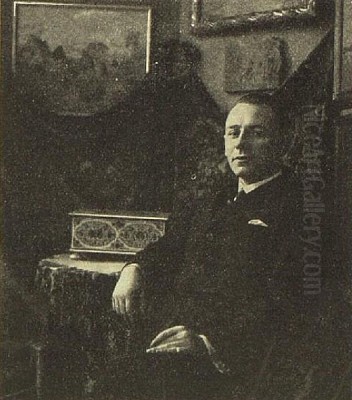
Gustav Macoun stands as a significant figure in the rich tapestry of Czech art history. Born in 1892 and active until his passing in 1934, Macoun dedicated his relatively short but impactful career to capturing the essence of the Czech landscape. Primarily recognized as a painter and decorative artist, he developed a distinctive style deeply rooted in Impressionist sensibilities, yet uniquely his own. His works resonate with a profound appreciation for his homeland's natural beauty, particularly its winter moods.
Macoun's artistic journey was shaped within the vibrant cultural milieu of Prague, his birthplace. He pursued formal training, eventually graduating from the prestigious Academy of Fine Arts in Prague (AVU). This institution was a crucible for artistic talent in Bohemia, fostering generations of influential artists. Macoun's education there provided him with a solid technical foundation and exposed him to the prevailing artistic currents of the time.
Early Life and Artistic Formation
Gustav Macoun's formative years as an artist were significantly influenced by prominent figures in the Czech art scene. He had the distinct advantage of studying under Alois Kalvoda (1875-1934) and Antonín Slavíček (1870-1910), both pivotal figures in the development of Czech Impressionism and modern landscape painting. Kalvoda was renowned for his lyrical depictions of birch groves and meadows, while Slavíček, despite his tragically short life, was a leading force, known for his dynamic brushwork and atmospheric cityscapes and landscapes, particularly views of Prague and the Kameničky region.
The guidance of these masters undoubtedly shaped Macoun's approach to light, color, and composition. Furthermore, sources suggest an influence from Václav Jansa (1859-1913), another notable Czech landscape painter known for his watercolors and historical scenes, who reportedly recommended Macoun for further study. This places Macoun firmly within the lineage of the Czech landscape tradition, which had seen significant development under figures like Julius Mařák (1832-1899) in the preceding generation, whose landscape school at the Academy had trained many key artists.
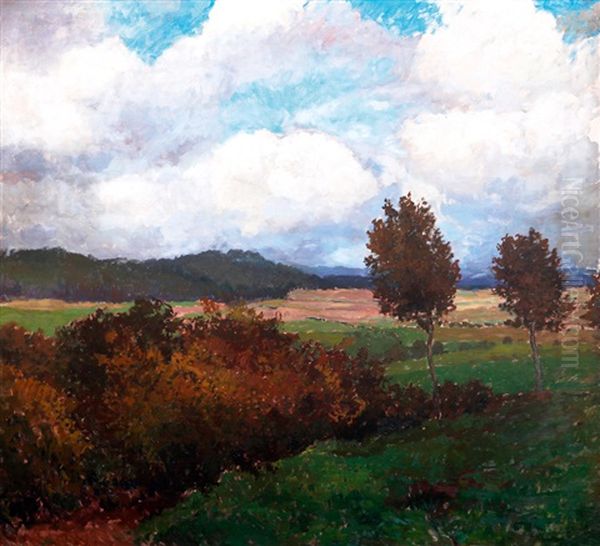
Macoun absorbed the lessons of Impressionism, particularly its emphasis on capturing fleeting moments, the effects of light, and painting en plein air, or at least achieving that sensibility in his studio work. However, he synthesized these influences into a personal style that went beyond mere imitation, focusing intently on the specific character of the Bohemian and Moravian landscapes he loved.
Forging a Unique Vision: Style and Subject Matter
Macoun distinguished himself through his dedicated focus on the Czech landscape, becoming one of its most evocative interpreters. He was particularly drawn to specific regions, returning to them repeatedly to capture their unique atmosphere. His canvases often feature the rolling hills and forests of the Vysočina (Czech Highlands), the picturesque scenery around Kameničky (a location also famously painted by Slavíček), and the broader vistas of the Czech lands.
His stylistic signature lies in his distinctive color palette. Macoun frequently employed broad areas of cool tones, with blues, greens, and greys dominating many of his compositions. This palette proved especially effective in his renowned depictions of winter. He possessed a remarkable ability to render the subtle nuances of light on snow, the stark beauty of leafless trees against a winter sky, and the quiet solitude of a snow-covered landscape. These winter scenes are perhaps his most celebrated works, showcasing his mastery of atmosphere and mood.
While rooted in Impressionistic observation, Macoun's paintings often possess a panoramic quality and a sense of grandeur that can touch upon Romantic sensibilities. His compositions are typically well-structured, capturing not just the appearance but also the spatial depth and inherent power of the natural world. He skillfully balanced detailed observation with expressive brushwork, creating landscapes that are both recognizable and emotionally resonant.
Signature Works and Thematic Exploration
Several key works exemplify Gustav Macoun's artistic achievements and thematic concerns. Titles like Mraky nad krajinou (Clouds over the Landscape) suggest his interest in capturing the dynamic interplay between earth and sky, a common theme in landscape painting. The mention of large-scale landscapes created around 1915, characterized by dominant greens and blues and dramatic cloud formations, points to a period where he aimed for monumental expressions of the national landscape.
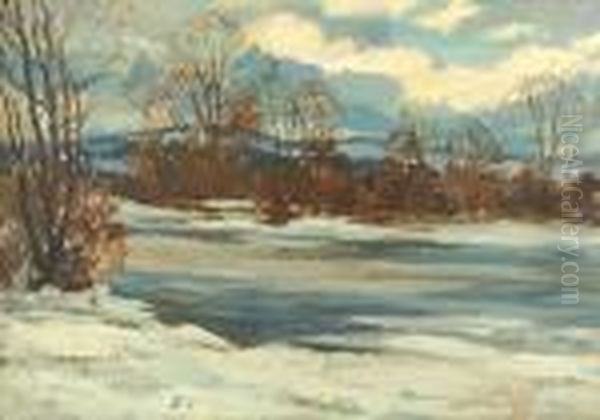
The painting Kameničky directly references the village and surrounding area in the Vysočina region, a place of pilgrimage for Czech landscape painters following Antonín Slavíček. Macoun's interpretation would have engaged with this artistic legacy, offering his own perspective on the well-loved motif. His winter scenes, often titled generically like Zimní krajina (Winter Landscape) or Vesnice v zimě (Village in Winter), showcase his specialization in capturing the specific light and atmosphere of the Czech winter.
Other recorded titles like Oblaka (Clouds), Letní den (Summer Day), Houby (Mushrooms), Břízky (Birches), and U zámku (At the Castle) indicate the breadth of his landscape subjects, moving beyond winter to embrace other seasons and specific landscape features. Works like Oblaka, noted as being reviewed by art historian PhDr. Michael Zachař, underscore the scholarly attention his oeuvre has received. Each work contributes to a cohesive vision centered on the Czech natural environment, rendered with his characteristic palette and compositional strength.
The Impressionist Context in Bohemia
To fully appreciate Macoun's contribution, it's helpful to place him within the broader context of Czech Impressionism and early 20th-century art. While French Impressionism provided the initial spark, Czech artists adapted its principles to their own cultural and geographical context. Antonín Slavíček's school, though informal, was highly influential, promoting a direct, emotive response to the landscape. Macoun, as a student of Slavíček, was part of this vital current.
He worked during a period of intense artistic activity in Prague. His contemporaries included other notable landscape painters who explored similar themes, often students of Mařák or Slavíček, such as Antonín Hudeček (1872-1941), known for his melancholic pond scenes and forest interiors; Otakar Lebeda (1877-1901), another brilliant but short-lived talent associated with Slavíček; and František Kaván (1866-1941), celebrated for his intimate winter landscapes.
While Macoun shared thematic interests with these artists, his specific handling of color and composition remained distinct. The Czech art scene at the time was diverse. Max Švabinský (1873-1962) excelled in portraiture and graphic arts, often with Symbolist undertones. Alfons Mucha (1860-1939) was achieving international fame with his iconic Art Nouveau posters and later dedicated himself to the monumental Slav Epic. Earlier foundational figures like Josef Mánes (1820-1871) represented the National Romantic spirit, while academic painters like Václav Brožík (1851-1901) focused on large-scale historical canvases. Macoun carved his niche within this complex landscape, focusing steadfastly on Impressionist-inspired landscape painting.
An Independent Path
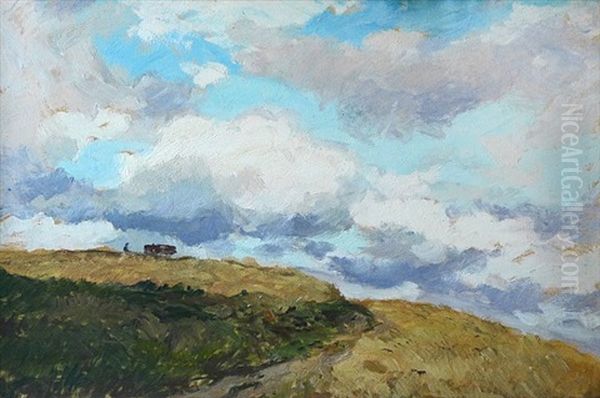
An interesting aspect of Macoun's career is that, despite his clear connections to the mainstream of Czech landscape painting through his teachers, he reportedly never joined any of the major artists' associations or societies. Groups like the Mánes Union of Fine Arts (Spolek výtvarných umělců Mánes) or the Umělecká beseda were central hubs for artistic life, organizing exhibitions and fostering debate.
Macoun's decision to remain independent might suggest a personality focused intensely on his studio practice, perhaps less inclined towards the organizational or social aspects of the art world. It could also reflect a desire to maintain complete artistic freedom, unburdened by the aesthetic programs or internal politics that sometimes characterized these associations. Whatever the reason, his independence did not seem to hinder his reputation or the reception of his work during his lifetime. His focus remained squarely on his artistic output, allowing the paintings themselves to represent him in the public sphere.
Exhibitions and Recognition
Despite his independence from formal associations, Gustav Macoun's work gained considerable recognition during his career. His paintings were exhibited, primarily in Prague, the center of the Czechoslovak art world. Some sources also mention exhibitions in other cities, potentially including Tartu, Klatovy, Cologne, and Gdansk, although details about these international showings might require further verification. Regardless, his work was visible and appreciated.
Crucially, his paintings found favor not only with the general public but also with official bodies. His works were acquired by public and state institutions within Czechoslovakia. This level of institutional recognition is a significant indicator of an artist's status and the perceived quality and importance of their work. It suggests that Macoun was seen as a relevant and accomplished painter contributing meaningfully to the national artistic heritage, particularly in the beloved genre of landscape painting. His ability to capture the specific character of the Czech lands resonated with both popular and official tastes.
Macoun in the Art Market: Auctions and Collections
The enduring appeal of Gustav Macoun's work is evident in its continued presence in the art market, particularly at Czech auction houses. Auction records provide valuable insights into the types of works available, their dimensions, and their market valuation over time. Notable sales have included Houby (50 x 60 cm), which sold for 17,000 CZK in November 2020, and Vesnice v zimě (49 x 64.5 cm), fetching 30,000 CZK in 2020, both handled by Galerie ART Praha.
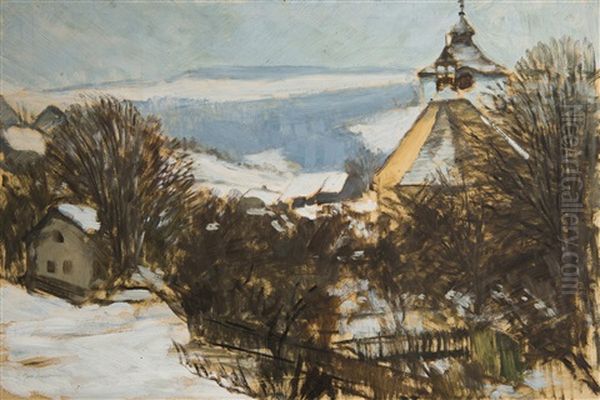
Larger works command higher prices, such as an oil on canvas (79.5 x 120 cm) estimated between 80,000 and 100,000 CZK in 2012, auctioned by Aukční Galerie Kodl and Vltavín. A significant Zimní krajina | WINTER LANDSCAPE (90 x 108.5 cm) sold for 32,000 CZK as recently as June 2024 via European Arts Investments. Other works like Oblaka (confirmed by PhDr. Michael Zachař), U zámku (49 x 69 cm), and Břízky (51 x 73 cm) have also appeared, though final prices aren't always publicly listed.
Auction houses like Galerie ART Praha, Aukční Galerie Kodl, Vltavín, CFIG Arts, and European Arts Investments regularly feature his paintings. This consistent market activity demonstrates a sustained interest among collectors for Macoun's evocative landscapes, confirming his status as a sought-after Czech painter of the early 20th century. The range of sizes and prices indicates accessibility for different levels of collectors, while the higher estimates for larger works reflect their significance.
Critical Acclaim and Art Historical Placement
Gustav Macoun is critically regarded as a master of Czech landscape painting, particularly lauded for his sensitive and atmospheric depictions of winter. Art historians recognize his stylistic roots in Impressionism, inherited through his studies with Kalvoda and Slavíček, but also note the personal inflection he brought to the style, sometimes incorporating elements that might be described as Post-Impressionist or possessing a subtle Romantic mood. His technical proficiency, especially his handling of color harmonies (the characteristic blue-greens and greys) and his ability to construct convincing, often panoramic, compositions, is frequently acknowledged.
Within the narrative of Czech art history, Macoun occupies an important position. He represents the continuation and evolution of the strong landscape tradition established by figures like Mařák and brought to an Impressionist peak by Slavíček. He stands alongside contemporaries like Hudeček and Kaván as key interpreters of the Czech countryside in the early decades of the 20th century. His work provides a bridge between the late 19th-century approaches and the developing trends of modernism, though he remained primarily focused on his specific landscape vision rather than engaging with more radical avant-garde movements. His dedication to the national landscape places him firmly within a central theme of Czech art, while his stylistic qualities ensure his distinctiveness.
Enduring Legacy
Gustav Macoun's legacy rests on his significant contribution to Czech landscape painting. Through his dedicated observation and skillful technique, he captured the unique beauty and atmosphere of the Bohemian and Moravian lands with a distinctive voice. His evocative winter scenes, in particular, remain highly regarded and sought after, demonstrating his mastery in conveying the specific moods and light conditions of that season.

Though his career was cut short by his death in 1934 at the age of 42, he produced a substantial body of work that continues to resonate with viewers. He successfully synthesized the influences of Czech Impressionism, particularly the legacy of his teachers Kalvoda and Slavíček, into a personal style characterized by cool palettes, atmospheric depth, and a profound connection to his native environment. As a key figure in the rich tradition of Czech landscape art, Gustav Macoun's paintings remain a testament to his talent and his enduring love for the landscapes he depicted. His work continues to be appreciated in collections and through the art market, securing his place in the annals of Czech art history.